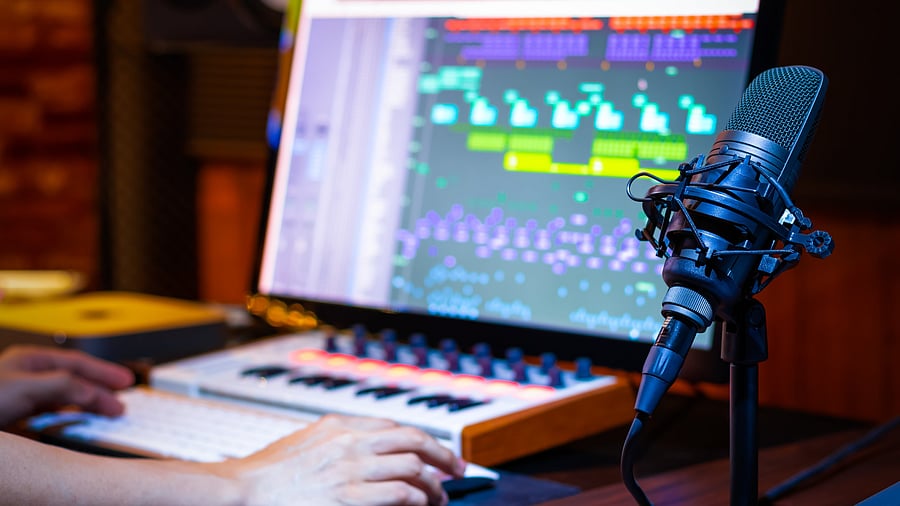
Representative image for music production
Credit: iStock Photo
The resurgence of re-releases of contemporary and critically acclaimed films in theatres is a telltale sign that we are in need of an explorative musical augmentation of narratives. Recently, after re-watching the classic film There Will Be Blood (2007), written and directed by Paul Thomas Anderson, on the big screen, I realised the importance of dissonance in background scores. Films are the closest we can get to encountering a social ‘con-sensus’ or sensing along with other people. They are an invitation into an experimentation with a polyphony of senses as well as our capacities for contemplative imagination. We tend to dismember the cinematic stream and later integrate it or ‘make sense’ of different scenes, stitching them in our subconscious through an acquired grammar of viewing and listening. This grammar gradually accumulates over previously sedimented experiences. While we construct this grammar, we are involved in a constructive process that helps us stay engaged with the narrative.
Background scores are agents that tug the story ‘forward’ in the most conventional sense. Filmmakers often make use of music to relieve the audience from the dominance of verbose language to ‘push’ the film. This directionality of storytelling in cinema can be suitably disrupted towards a more contemplative form through the use of dissonance in music. Dissonance in music is an intertwined relationality between melody, anticipation and revelation. The excitement of dissonance arises when we hunt a route that restructures our subservient constructs of musical grammar, be it through melody, instruments, entry points or dynamics. There are pathways in musical scales which the brain conveniently anticipates and completes as a whole when encountered with only a part. We tend to embrace this resolution and become satisfied too soon. Moving away from this embrace is an occasion for dissonance to hone our absorptive capacities for stories. It puts us into a state of introspection when we aren’t able to ‘complete’ the pathways too easily. We can explore four ‘turns’ of dissonance in background scores.
The director’s voice and the actor’s dynamic, as well as the dialogue, affect our stream of consciousness when we are chewing on a scene. The interplay between the three can be facilitated through a passive presence of dissonant music. The reveal of a character’s trait can be sometimes concealed through a certain dissonance in musical composition, as the music composer Jonny Greenwood does in There Will Be Blood. When characters speak to each other, the dominant musical palette of cellos and violins shrieks in an intuitively intoxicating manner, kept far in the background and low in volume. The embedded association of these instruments is with ‘ordered music’ or ‘Western classical music’. This is the first turn of dissonance, where the choice of instrument moves away from its associated family of music. As these sonic breadcrumbs are introduced to us in every scene, we start to store the seeds of an aural grammar. The subservient attachment of this grammar with an event or a trait of a character is highly unpredictable.
In There Will Be Blood, after the verbal sequences in the film, the feeble background score suddenly escalates in volume, washing over our ears like thick flowing batter while montage-like sequences or large landscape-based visuals give us time to store our loosely constructed anticipations of where the film might be headed. By modulating volume, a second turn of dissonance occurs as a shakedown. A shakedown is needed at times when the audience is given easy control of the narrative. We might empathise or disagree with a character’s moral grounding, or we might be obsessed with the events flowing by themselves, depending on the constitution of our acquired musical grammar.
The third turn of dissonance occurs through melodic transformation. When piano notes right next to each other are played together or in succession, we perceive a form of tension that waits to be resolved. We reach an unexpected cliff in our listening landscape. Tinkering with instruments in unusual ways, using the human voice to translate a thought or even a conversation into a tune can help us explore unusual ‘scales’ or patterns in melodies. Jonny Greenwood explores the various ways in which he could play a cello in order to produce eerie textures that defy directionality in music. Unpredictable entry points of background music in the film cause a radical focal shift from the character’s perspective towards the overall arc of the narrative, forming the fourth turn of dissonance.
Musical dissonance encourages non-directional exploration of narratives.
The orthodox formula of underlining straightforward narratives with highly predictable and homogenous background music is no longer an inviting mode of immersion in cinema. Moving toward a contemplative mode is necessary in order to preserve this inherently temporal, transformative and interactive form of audiovisual storytelling.
(The writer is a Bengaluru-based author and musician)